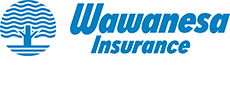Minesing Wetlands
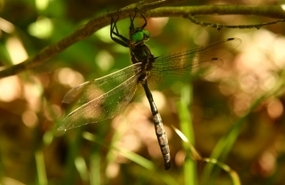
Hine's emerald dragonfly at Minesing Wetlands, ON (Photo by Chris Evans)
Why this place is important
Located 15 kilometres west of Barrie lies one of the largest and least disturbed wetlands in southern Ontario. Comprising approximately 10,937 hectares (27,025 acres) of wetlands, fields and forests, the Minesing Wetlands are often referred to as the “Everglades of the North” due to their designation as a Ramsar Wetland of International Importance — a distinction they share with their Floridian counterpart.
The vast collection of marshes, fens and treed swamps support more than 30 at-risk species, including least bittern and cerulean warbler. It is also the only known location for the endangered Hine’s emerald dragonfly in Canada.
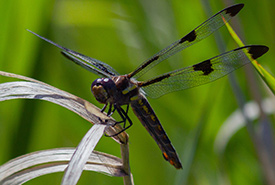
Twelve-spotted skimmer, dragonfly count, Minesing Wetlands, ON (Photo by NCC)
The Minesing Wetlands support a wide variety of wetland birds and waterfowl, which flock to the area in the tens of thousands during spring migration when most of the wetlands resemble a large lake. These species-rich wetlands are also important in providing flood control, water filtration, fish habitat and recreational opportunities. Over 70 per cent of southern Ontario’s wetlands have been converted to alternative uses since European settlement. The remaining wetlands are threatened by non-native invasive plant species, pollution and habitat fragmentation.
Part of this rare natural area is also designated as a Provincially Significant Wetland and an Area of Natural and Scientific Interest.
Many watercourses, including the Mad River, Willow Creek and Nottawasaga River, meet in Minesing before flowing out into Georgian Bay. You can canoe or kayak the rivers and paddle right over their banks during the annual spring flood, into the expanses of treed wetland and open marsh.
What NCC is doing
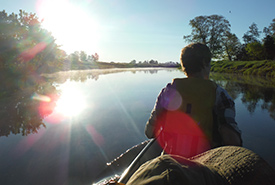
Minesing Wetlands bioblitz, ON (Photo by NCC)
The Minesing Wetlands is one of the Nature Conservancy of Canada’s (NCC’s) oldest active natural areas. Since 1974, NCC and our partners have protected over 5,500 hectares (13,600 acres) of conservation lands, many of which are now owned and managed by NCC’s primary partner on the landscape: the Nottawasaga Valley Conservation Authority.
Since 1962, NCC and our partners have delivered restoration and protection programs, including reforestation, stream bank stabilization, erosion control and nutrient management projects, and invasive species control. These projects help reduce and sequester phosphorus, improve streamside shading and create habitat for many native species. Since 2010, NCC and our partners have restored approximately 25 hectares (61 acres) of deciduous swamp forest, buffered 12 kilometres of rivers and streams and controlled 3 hectares (8 acres) of invasive species in the Minesing Wetlands Natural Area.
NCC also assists in the recovery of the Hine's emerald dragonfly and other species at risk by helping recovery teams carry out priority actions. In 2018, NCC celebrated the protection of the 43-hectare (107-acre) Patrick W. E. Hodgson Property — a known location for the Hine's emerald.
What lives here
These are some of the significant and at-risk species found in this natural area:
Reptiles, amphibians and turtles
- Blanding's turtle - Great Lakes / St. Lawrence population (endangered)
- common map turtle (special concern)
- midland painted turtle (special concern)
- milksnake (special concern)
- snapping turtle (special concern)
- western chorus frog - Great Lakes - St. Lawrence - Canadian Shield population (threatened)
Birds
- bank swallow (threatened)
- barn swallow (threatened)
- bobolink (threatened)
- Canada warbler (threatened)
- cerulean warbler (endangered)
- chimney swift (threatened)
- common nighthawk (special concern)
- eastern meadowlark (threatened)
- eastern wood-pewee (special concern)
- golden-winged warbler (threatened)
- grasshopper sparrow - pratensis subspecies (special concern)
- Henslow's sparrow (endangered)
- horned grebe - western population (special concern)
- least bittern (threatened)
- olive-sided flycatcher (special concern)
- prothonotary warbler (endangered)
- red-headed woodpecker (endangered)
- rusty blackbird (special concern)
- short-eared owl (special concern)
- wood thrush (threatened)
Insects
- Hine's emerald dragonfly (endangered)
- monarch butterfly (endangered)
Plants
- black ash (threatened)
- butternut (endangered)
- eastern prairie white-fringed orchid (endangered)
Fish
- lake sturgeon - Great Lakes - upper St. Lawrence populations (threatened)
- northern brook lamprey - Great Lakes - upper St. Lawrence populations (special concern)
Mammals
- little brown myotis (endangered)
Threats
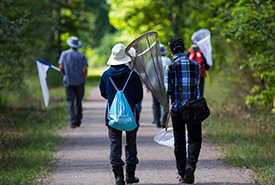
Dragonfly count, Minesing Wetlands, ON in 2019 (Photo by NCC)
Unlike many wetlands in southern Ontario, the Minesing Wetlands have remained largely intact. However, changes in surrounding land use and invasive species threaten this internationally important ecosystem.
One threat facing the Minesing Wetlands is the reduction in swamp forest habitat due to a variety of factors, including changes to the water table. In recent years, NCC and partners have worked to protect and restore buffer lands that surround the core wetlands of Minesing.
When former farm fields are reforested, it filters runoff before it reaches waterways and wetlands, provides protection from flooding for surrounding areas and offers additional habitat for the area’s species at risk.
While not as affected as coastal Great Lakes’ wetlands further south, Minesing does face the threat of invasive phragmites. Yearly monitoring, mapping and control efforts are helping NCC and our partners stay ahead of this extremely destructive invasive wetland plant.
History
The Minesing Wetlands played an important, if little known, role in the War of 1812. With control of Lake Erie lost to the Americans after a decisive naval battle in 1813, the British were forced to seek an alternate route that linked York (Toronto) to their warships on Lake Huron at Fort Mackinac (present day Mackinac Island, Michigan), where the garrison was running desperately low on supplies.
In 1814, 200 soldiers and a small party of sailors travelled north from York into the forests of Upper Canada, across Lake Simcoe and into the Minesing Wetlands — all to deliver the badly needed supplies. Among what must have been swarms of mosquitos, and dressed in heavy wool uniforms, soldiers suffered a gruelling 14.5-kilometre portage that ended on the banks of Willow Creek. Here, the sailors and soldiers loaded the supplies into boats, navigated through the rest of the swamp and down the Nottawasaga River into Georgian Bay, eventually reaching Fort Mackinac.
Minesing’s strategic location prompted the British to establish a supply depot, Fort Willow, within the wetlands. The fort became a very important link in the chain to the backcountry.
With files from Canadian Geographic
Partners
The protection of the Minesing Wetlands is not something we can achieve on our own. Only through strong partnerships can this unique area continue to grow and thrive. NCC would like to thank the following partners for their generous support of our ongoing efforts in this natural area:
- Nottawasaga Valley Conservation Authority
- Friends of Minesing Wetlands
- Ducks Unlimited Canada
- Ontario Power Generation
- Local landowners and community members
Current Projects
Click here to learn more about our current projects in the Minesing Wetlands Natural Area.



